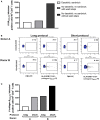Flow Cytometric Clinical Immunomonitoring Using Peptide-MHC Class II Tetramers: Optimization of Methods and Protocol Development
- PMID: 29403492
- PMCID: PMC5786526
- DOI: 10.3389/fimmu.2018.00008
Flow Cytometric Clinical Immunomonitoring Using Peptide-MHC Class II Tetramers: Optimization of Methods and Protocol Development
Abstract
With the advent of novel strategies to induce tolerance in autoimmune and autoimmune-like conditions, clinical trials of antigen-specific tolerizing immunotherapy have become a reality. Besides safety, it will be essential to gather mechanistic data on responding CD4+ T cells to assess the effects of various immunomodulatory approaches in early-phase trials. Peptide-MHC class II (pMHCII) multimers are an ideal tool for monitoring antigen-specific CD4+ T cell responses in unmanipulated cells directly ex vivo. Various protocols have been published but there are reagent and assay limitations across laboratories that could hinder their global application to immune monitoring. In this methodological analysis, we compare protocols and test available reagents to identify sources of variability and to determine the limitations of the tetramer binding assay. We describe a robust pMHCII flow cytometry-based assay to quantify and phenotype antigen-specific CD4+ T cells directly ex vivo from frozen peripheral blood mononuclear cell samples, which we suggest should be tested across various laboratories to standardize immune-monitoring results.
Keywords: antigen-specific T cells; flow cytometry; protocol standardization; tetramerization; tetramers.
Figures



Similar articles
-
Optimized combinatorial pMHC class II multimer labeling for precision immune monitoring of tumor-specific CD4 T cells in patients.J Immunother Cancer. 2020 May;8(1):e000435. doi: 10.1136/jitc-2019-000435. J Immunother Cancer. 2020. PMID: 32448802 Free PMC article. Clinical Trial.
-
Visualizing antigen specific CD4+ T cells using MHC class II tetramers.J Vis Exp. 2009 Mar 6;(25):1167. doi: 10.3791/1167. J Vis Exp. 2009. PMID: 19270641 Free PMC article.
-
Use of MHC class II tetramers to investigate CD4+ T cell responses: problems and solutions.Cytometry A. 2008 Nov;73(11):1010-8. doi: 10.1002/cyto.a.20603. Cytometry A. 2008. PMID: 18612991
-
MHC Class II tetramers and the pursuit of antigen-specific T cells: define, deviate, delete.Clin Immunol. 2004 Mar;110(3):232-42. doi: 10.1016/j.clim.2003.11.004. Clin Immunol. 2004. PMID: 15047201 Review.
-
[MHC tetramers: tracking specific immunity].Acta Med Croatica. 2003;57(4):255-9. Acta Med Croatica. 2003. PMID: 14639858 Review. Croatian.
Cited by
-
Dendritic cells, T cells and their interaction in rheumatoid arthritis.Clin Exp Immunol. 2019 Apr;196(1):12-27. doi: 10.1111/cei.13256. Epub 2019 Jan 21. Clin Exp Immunol. 2019. PMID: 30589082 Free PMC article. Review.
-
Optimized combinatorial pMHC class II multimer labeling for precision immune monitoring of tumor-specific CD4 T cells in patients.J Immunother Cancer. 2020 May;8(1):e000435. doi: 10.1136/jitc-2019-000435. J Immunother Cancer. 2020. PMID: 32448802 Free PMC article. Clinical Trial.
-
Multi-HLA class II tetramer analyses of citrulline-reactive T cells and early treatment response in rheumatoid arthritis.BMC Immunol. 2020 May 18;21(1):27. doi: 10.1186/s12865-020-00357-w. BMC Immunol. 2020. PMID: 32423478 Free PMC article.
-
Multiple environmental antigens may trigger autoimmunity in psoriasis through T-cell receptor polyspecificity.Front Immunol. 2024 Mar 8;15:1374581. doi: 10.3389/fimmu.2024.1374581. eCollection 2024. Front Immunol. 2024. PMID: 38524140 Free PMC article.
-
Evaluation of a fit-for-purpose assay to monitor antigen-specific functional CD4+ T-cell subpopulations in rheumatoid arthritis using flow cytometry-based peptide-MHC class-II tetramer staining.Clin Exp Immunol. 2022 Jan 28;207(1):72-83. doi: 10.1093/cei/uxab008. Clin Exp Immunol. 2022. PMID: 35020859 Free PMC article.
References
Publication types
MeSH terms
Substances
LinkOut - more resources
Full Text Sources
Other Literature Sources
Research Materials

